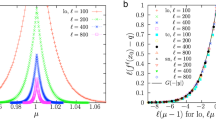Abstract
We consider two-dimensional overdamped double-well systems perturbed by white noise. In the weak-noise limit the most probable fluctuational path leading from either point attractor to the separatrix (the most probable escape path, or MPEP) must terminate on the saddle between the two wells. However, as the parameters of a symmetric double-well system are varied, a unique MPEP may bifurcate into two equally likely MPEPs. At the bifurcation point in parameter space, the activation kinetics of the system become non-Arrhenius. We quantify the non-Arrhenius behavior of a system at the bifurcation point, by using the Maslov-WKB method to construct an approximation to the quasistationary probability distribution of the system that is valid in a boundary layer near the separatrix. The approximation is a formal asymptotic solution of the Smoluchowski equation. Our construction relies on a new scaling theory, which yields “critical exponents” describing weak-noise behavior at the bifurcation point, near the saddle.
Similar content being viewed by others
References
M. Abramowitz and I. A. Stegun, eds.,Handbook of Mathematical Functions (Dover, New York, 1965).
V. I. Arnol'd, Critical points of smooth functions and their normal forms,Russ. Math. Surv. 30(5):1–75 (1975).
A. Auerbach and S. Kivelson, The path decomposition and multidimensional tunneling,Nucl. Phys. B 257[FS 14]:799–858 (1985).
M. V. Berry, Waves and Thom's theorem,Adv. Phys. 25:1–26 (1976).
M. V. Berry and N. L. Balazs, Evolution of semiclassical quantum states in phase space,J. Phys. A 12:625–642 (1979).
A. J. Bray and A. J. McKane, Instanton calculation of the escape rate for activation over a potential barrier driven by colored noise,Phys. Rev. Lett. 62:493–496 (1989).
B. Carmeli, V. Mujica, and A. Nitzan, Dynamics of multidimensional barrier crossing in the overdamped limit,Ber. Bunsen ges. 95:319–326 (1991).
B. Caroli, C. Caroli, B. Roulet, and J.-F. Gouyet, A WKB treatment of diffusion in a multidimensional bistable potential,J. Stat. Phys. 22:515–536 (1980).
M. V. Day, Recent progress on the small parameter exit problem,Stochastics 20:121–150 (1987).
J. J. Duistermaat, Oscillatory integrals, Lagrange immersions, and unfolding of singularities,Commun. Pure Appl. Math. 27:207–281 (1974).
M. I. Dykman, P. V. E. McClintock, V. N. Smelyanskiy, N. D. Stein, and N. G. Stocks, Optimal paths and the prehistory problem for large fluctuations in noise-driven systems,Phys. Rev. Lett. 68:2718–2721 (1992).
M. I. Dykman, M. M. Millonas, and V. N. Smelyanskiy, Observable and hidden singular features of large fluctuations in nonequilibrium systems,Phys. Lett. A 195:53–58 (1994).
J.-P. Eckmann and R. Sénéor, The Maslov-WKB method for the (an-)harmonic oscillator,Arch. Rat. Mech. Anal. 61:153–173 (1976).
M. I. Freidlin and A. D. WentzellRandom Perturbations of Dynamical Systems (Springer-Verlag, New York, 1984).
S. Glasstone, K. J. Laidler, and H. Eyring,The Theory of Rate Processes (McGraw-Hill, New York, 1941).
R. Graham, Macroscopic potentials, bifurcations and noise in dissipative systems, inTheory of Continuous Fokker-Planck Systems, F. Moss and P. V. E. McClintock, eds. (Cambridge University Press, Cambridge, 1989), Chapter 7, pp. 225–278.
M. C. Gutzwiller, Periodic orbits and classical quantization conditions,J. Math. Phys. 12:343–358 (1971).
M. C. Gutzwiller,Chaos in Classical and Quantum Mechanics (Springer-Verlag, Berlin, 1990).
H. R. Jauslin, Nondifferentiable potentials for nonequilibrium steady states,Physica A 144:179–191 (1987).
J. B. Keller, Corrected Bohr-Sommerfeld quantum conditions for non-separable systems,Ann. Phys. 4:180–188 (1958).
M. M. Kłosek-Dygas, B. M. Hoffman, B. J. Matkowsky, A. Nitzan, M. A. Ratner, and Z. Schuss, Diffusion theory of multidimensional activated rate processes: The role of anisotropy.J. Chem. Phys. 90:1141–1148 (1989).
H. A. Kramers, Brownian motion on a field of force and the diffusion model of chemical reactions,Physica 7:284–304 (1940).
R. Landauer, Motion out of noisy states,J. Stat. Phys. 53:233–248 (1988).
J. S. Langer, Statistical theory of the decay of metastable states,Ann. Phys. 54:258–275 (1969).
R. G. Littlejohn, The Van Vleck formula, Maslov theory, and phase space geometry,J. Stat. Phys. 68:7–50 (1992).
D. Ludwig, Persistence of dynamical systems under random perturbations,SIAM Rev. 17:605–640 (1975).
S.-K. Ma,Modern Theory of Critical Phenomena (Benjamin, Reading, Massachusetts, 1976).
R. S. Maier and D. L. Stein, The effect of focusing and caustics on exit phenomena in systems lacking detailed balance,Phys. Rev. Lett. 71:1783–1786 (1993).
R. S. Maier and D. L. Stein, The escape problem for irreversible systems,Phys. Rev. E 48:931–938 (1993).
R. S. Maier and D. L. Stein, Limiting exit location distributions in the stochastic exit problem,SIAM J. Appl. Math., provisionally accepted.
M. Mangel, Barrier transitions driven by fluctuations with applications to evolution and ecology,Theoret. Popul. Biol. 45:16–40 (1994).
V. P. Maslov and M. V. Fedoriuk,Semi-Classical Approximation in Quantum Mechanics (Reidel, Dordrecht, 1981).
T. Naeh, M. M. Kłosek, B. J. Matkowsky, and Z. Schuss, A direct approach to the exit problem,SIAM J. Appl. Math. 50:595–627 (1990).
L. Onsager and S. Machlup, Fluctuations and irreversible processes,Phys. Rev. 91:1505–1512 (1953).
R. B. Paris, The asymptotic behaviour of Pearcey's integral for complex variables,Proc. R. Soc. Lond. A 432:391–426 (1991).
L. S. Schulman,Techniques and Applications of Path Integrations (Wiley, New York, 1981).
M. A. Shayman, A geometric view of the matrix Riccati equation, inThe Riccati Equation, S. Bittanti, A. J. Laub, and J. C. Willems, eds. (Springer-Verlag, Berlin 1991), pp. 89–112.
P. Talkner, Mean first passage times and the lifetime of a metastable state.Z. Phys. B 68:201–207 (1987).
Author information
Authors and Affiliations
Rights and permissions
About this article
Cite this article
Maier, R.S., Stein, D.L. A scaling theory of bifurcations in the symmetric weak-noise escape problem. J Stat Phys 83, 291–357 (1996). https://doi.org/10.1007/BF02183736
Received:
Issue Date:
DOI: https://doi.org/10.1007/BF02183736
Key Words
- Boundary layer
- caustics
- double well
- Fokker-Planck equation
- Lagrangian manifold
- large deviation theory
- large fluctuations
- Maslov-WKB method
- non-Arrhenius behavior
- nongeneric caustics
- Pearcey function
- singular perturbation theory
- Smoluchowski equation
- stochastic escape problem
- stochastic exit problem
- stochastically perturbed dynamical systems
- weak noise
- Wentzell-Freidlin theory
- WKB approximation




